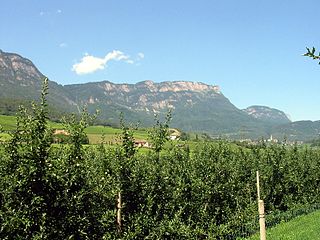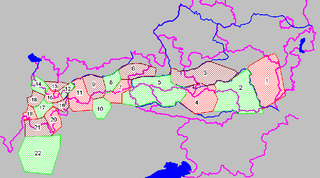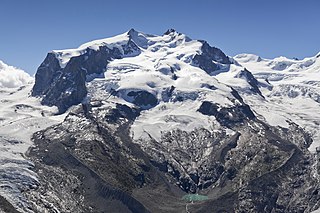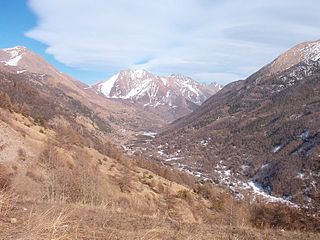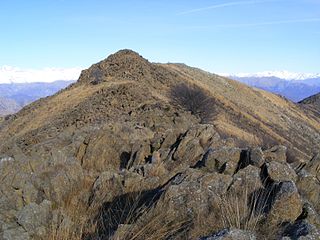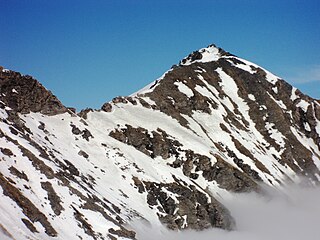| Nonsberg Group | |
|---|---|
The twin peaks of the Laugenspitze | |
| Highest point | |
| Peak | Laugenspitze |
| Elevation | 2,434 m s.l.m. |
| Geography | |
| State | South Tyrol and Trentino, Italy |
| Range coordinates | 46°32′05″N11°05′09″E / 46.53472°N 11.08583°E Coordinates: 46°32′05″N11°05′09″E / 46.53472°N 11.08583°E |
| Parent range | Eastern Alps |
The Nonsberg Group (German : Nonsberggruppe, Italian : Alpi della Val di Non) is a mountain range in South Tyrol and Trentino in Italy and part of the Southern Limestone Alps. A large part of the Nonsberg Group is formed by the Mendelkamm. Their highest peak is the Laugenspitze (2,434 m s.l.m. ). The Nonsberg Group is bounded in the east by the Etschtal, to the north by the Prissian High Forest (Ger: Prissianer Hochwald, It: Selva di Prissiano) on the Gampen Pass (It: Passo delle Palade) and in the west by the Non Valley (Ger: Nonstal, It: Val di Non).

German is a West Germanic language that is mainly spoken in Central Europe. It is the most widely spoken and official or co-official language in Germany, Austria, Switzerland, South Tyrol (Italy), the German-speaking Community of Belgium, and Liechtenstein. It is also one of the three official languages of Luxembourg and a co-official language in the Opole Voivodeship in Poland. The languages which are most similar to German are the other members of the West Germanic language branch: Afrikaans, Dutch, English, the Frisian languages, Low German/Low Saxon, Luxembourgish, and Yiddish. There are also strong similarities in vocabulary with Danish, Norwegian and Swedish, although those belong to the North Germanic group. German is the second most widely spoken Germanic language, after English.

Italian is a Romance language of the Indo-European language family. Italian, together with Sardinian, is by most measures the closest language to Vulgar Latin of the Romance languages. Italian is an official language in Italy, Switzerland, San Marino and Vatican City. It has an official minority status in western Istria. It formerly had official status in Albania, Malta, Monaco, Montenegro (Kotor) and Greece, and is generally understood in Corsica and Savoie. It also used to be an official language in the former Italian East Africa and Italian North Africa, where it plays a significant role in various sectors. Italian is also spoken by large expatriate communities in the Americas and Australia. In spite of not existing any Italian community in their respective national territories and of not being spoken at any level, Italian is included de jure, but not de facto, between the recognized minority languages of Bosnia-Herzegovina and Romania. Many speakers of Italian are native bilinguals of both standardized Italian and other regional languages.

South Tyrol is an autonomous province in northern Italy. It is one of the two autonomous provinces that make up the autonomous region of Trentino-Alto Adige/Südtirol. Its official trilingual denomination is Autonome Provinz Bozen – Südtirol in German, Provincia autonoma di Bolzano – Alto Adige in Italian and Provinzia autonoma de Bulsan – Südtirol in Ladin, reflecting the three main language groups to which its population belongs. The province is the northernmost of Italy, the second largest, with an area of 7,400 square kilometres (2,857 sq mi) and has a total population of 530,009 inhabitants as of 2018. Its capital and largest city is Bolzano.




